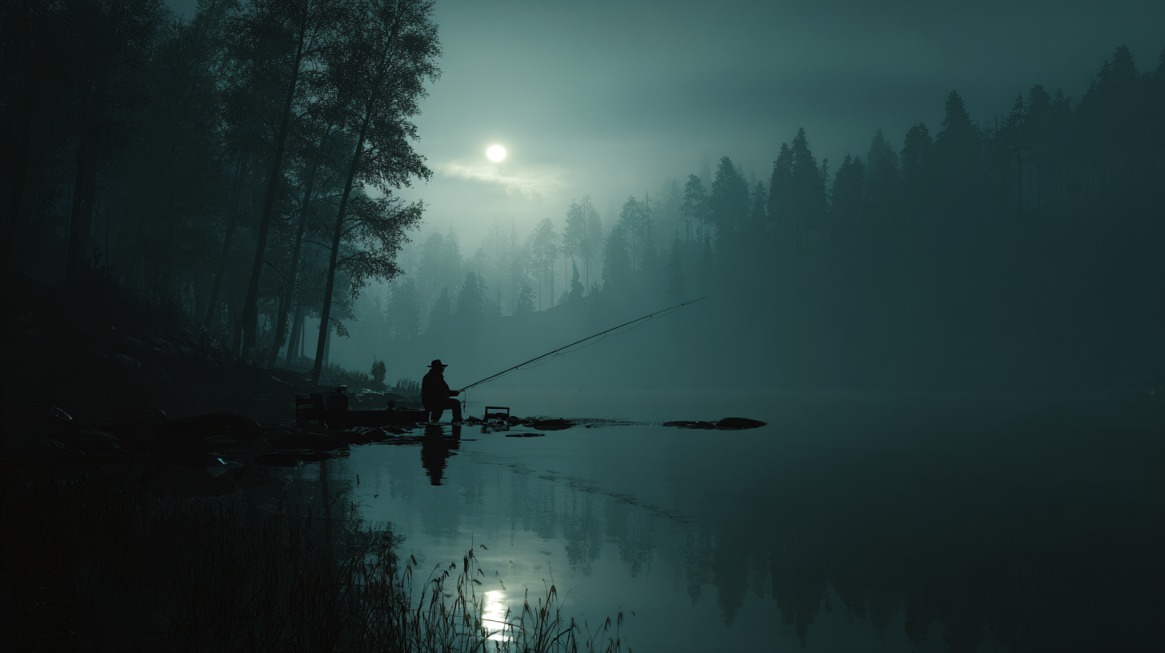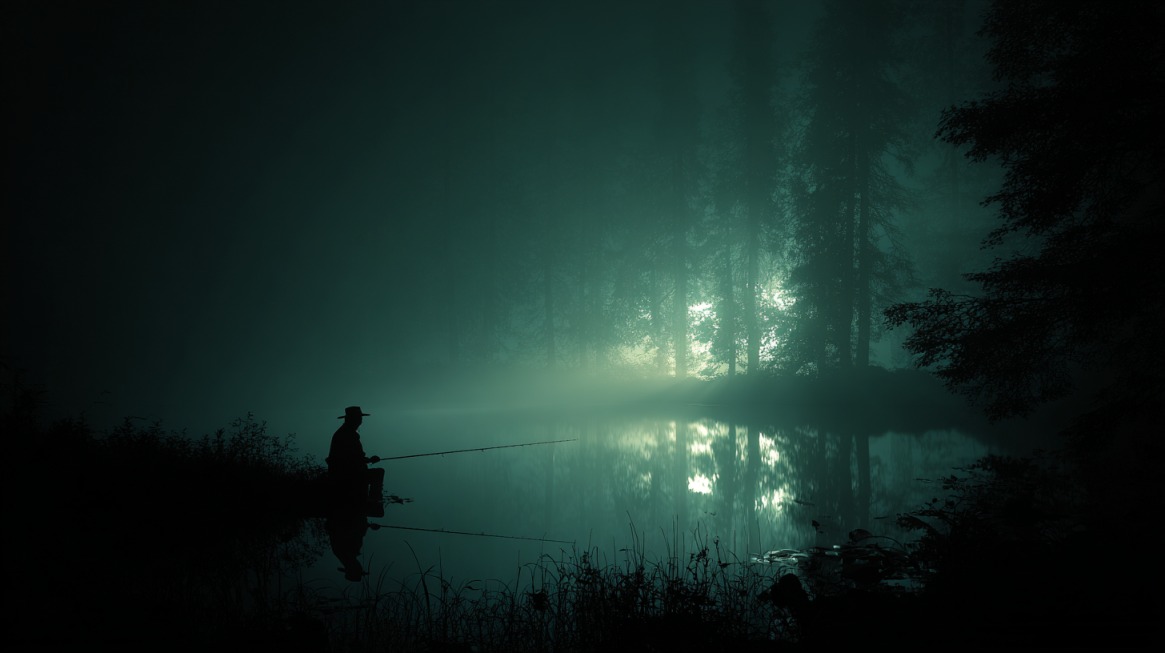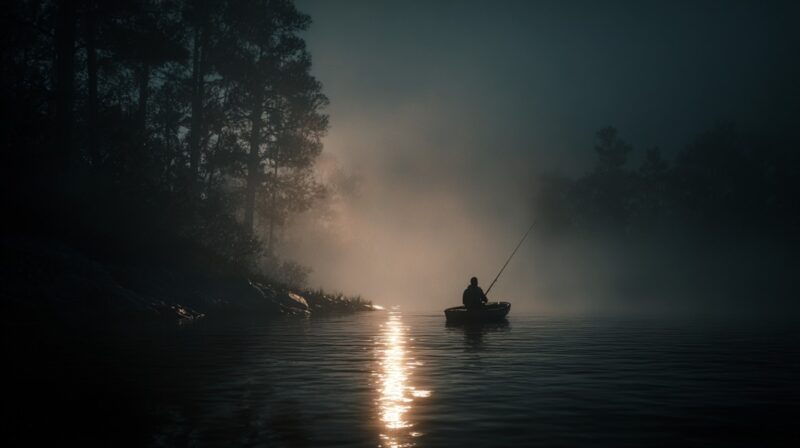Fishing in the dark an exciting and productive experience. During warmer months, fish tend to feed more actively at night, creating ideal conditions for a successful outing.
The quiet atmosphere and cooler temperatures make for a comfortable fishing environment, and popular spots are often less crowded, giving anglers a sense of solitude and tranquility.
With the right preparation and techniques, fishing after dark can be a safe and rewarding experience, offering opportunities to catch a variety of species that are more active in the dark.
Key Takeaways
- Fish are more active after sunset, especially during warmer months.
- Fishing in the dark offers a unique and exciting experience.
- Cooler temperatures and quieter environments make for comfortable fishing conditions.
- Popular fishing spots are often less crowded at night.
- Proper preparation is key to a safe and successful night fishing experience.
Why Night Fishing Offers Better Opportunities

The transition from day to night brings about significant changes in fish behavior, making night fishing a potentially rewarding experience. As the sun sets and daylight fades, the underwater world undergoes a transformation that can greatly benefit anglers.
Fish Behavior Changes After Dark
Like other predators, fish use the cover of darkness to hunt more actively. This makes night fishing an excellent time to catch species that might be shy during daylight hours.
Most fish move closer to the surface at night because that’s where natural light filters through. Fish depend more on scent and vibration than sight during nighttime hours, using their lateral lines to detect movement and vibrations in the water.
As “the darkness allows fish to feel more secure, making them less cautious and more likely to strike at prey.”
When summer heat becomes oppressive, it has a significant impact on fish, driving them into deeper, cooler waters during the day. However, they return to the shallows to feed after dark when surface temperatures become more comfortable.
- Predatory fish use the cover of darkness as a hunting advantage, moving into shallower waters and feeding more aggressively.
- Fish rely more on their lateral line and sense of smell at night, changing how they locate and strike at prey.
Less Competition and Quieter Waters
One of the significant advantages of night fishing is having less competition from other anglers. Popular fishing spots that are crowded during the day often become vacant at night, providing a more peaceful environment.
The absence of boat traffic and other human activity creates quieter waters, allowing fish to feed more confidently without disturbance.
Overall, night fishing offers a unique combination of increased fish activity and reduced competition, making it an attractive option for anglers looking to catch more fish.
Essential Night Fishing Tips That Guarantee Success
Night fishing requires a different approach than daytime fishing, and there are several key strategies to increase your chances of success. Understanding the behavior of fish in the dark and adapting your techniques accordingly is crucial for a productive night fishing trip.
Choosing the Right Bait and Lures for Darkness
For fishing in the dark, live bait usually works better than artificial lures because fish rely more on scent and vibration than sight. However, if you prefer to use lures, dark colors like black or purple create the best silhouettes against the night sky.
Surface lures with rattles are particularly effective at night as the noise helps fish locate your bait in the darkness. The vibration and sound become crucial when fishing in the dark, making rattling lures, spinnerbaits, and buzzbaits excellent choices.
Working the Water Column Effectively
Many fish species move shallower and closer to the surface after dark, so it’s essential to work the water column effectively. Start with your bait near the top and adjust based on the action. This approach will help you determine where the fish are holding and increase your chances of a catch.
Slowly working your way through the water column, from the surface to the bottom, will help you cover all potential holding areas for fish.
Timing Your Night Fishing Trip for Maximum Results
The best action typically starts an hour or two after dark, so it’s crucial to time your night fishing trip accordingly. Avoid packing up immediately after sunset, as most fish species take a short break during the switch from day to night.
Full moon nights often produce the best results, as fish use the natural light to feed more actively. Planning your trips around full moon periods can significantly improve your night fishing success.
Finding the Best Spots for Night Fishing

Effective night fishing starts with understanding where to find the best fishing spots. Success in night fishing comes down to picking the right location, and there are several types of areas that are particularly productive. You can always use a fish finder to be sure you’re in the right place.
Artificial Light Areas: Bridges, Docks and Piers
Areas with artificial lighting from bridges, docks, or piers are prime spots for night fishing. These structures attract baitfish, which in turn draw in larger predators.
The “edge effect” is particularly relevant here, as predatory fish often position themselves at the boundary between light and darkness, waiting to ambush unsuspecting prey.
Natural Structures and Spawning Areas
Natural structures such as points, drop-offs, and shallow flats can be very productive at night, especially during spring when larger fish move shallow to spawn. These areas provide ambush points for predators and feeding grounds for a variety of fish species.
Anchoring vs. Drifting at Night
When it comes to night fishing, anchoring is often preferable to drifting or trolling. Anchoring allows for more precise presentations and reduces navigation hazards. By staying in one spot, you can focus entirely on catching fish instead of managing your boat in the dark.
| Location Type | Characteristics | Fish Attracted |
|---|---|---|
| Artificial Light Areas | Bridges, docks, piers with artificial lighting | Baitfish, larger predators |
| Natural Structures | Points, drop-offs, shallow flats | Variety of fish species |
| Spawning Areas | Shallow areas, especially during spring | Larger fish moving shallow to spawn |
Must-Have Gear for Successful Night Fishing
View this post on Instagram
Night fishing requires a distinct set of gear to ensure a successful and safe experience. Having the right equipment can make a significant difference in your ability to catch fish and navigate the waters in the dark.
Lighting Equipment: Headlamps, Spotlights and Fish Attractants
Lighting is a critical component of night fishing. Headlamps provide hands-free operation, allowing you to tie knots or bait hooks without fumbling. Spotlights are essential for navigation, helping you to see obstacles and other boats.
Underwater fish-attracting lights, particularly green LED lights, have been shown to be highly effective in drawing in baitfish.
Specialized Fishing Equipment for Nighttime
Night fishing demands specialized fishing gear that can help detect subtle bites and withstand the challenges of low-light conditions. Sensitive rods and reels are crucial for feeling even the lightest bites.
Dark-colored lures with rattles can help attract fish in the dark. Additionally, having a cast or dip net for catching live bait can be very beneficial.
Safety Gear You Shouldn’t Leave Shore Without
Safety should always be a top priority when night fishing. Ensure your boat is equipped with properly functioning navigation lights. Life jackets are a must, and consider wearing an inflatable PFD or belt pack at all times. Emergency communication devices and first aid supplies are also essential.
Using glow sticks or LED markers on your gear can prevent frustrating searches in the dark.
Organizing your tackle and gear for efficient access is also crucial. This can prevent fumbling and potential accidents when reaching for tools or lures in the dark.
Specialized line that is more visible or manageable in low-light conditions can help anglers maintain better control of their presentations. Tools like line clippers and hook removers that can be operated one-handed are also highly recommended.
Lastly, don’t forget to dress appropriately for the conditions. Temperatures often drop significantly after sunset, even during spring and summer months. Being prepared with the right clothing can make your night fishing experience much more enjoyable.
Conclusion: Mastering the Art of Fishing in the Dark
The cover of darkness can be a game-changer for fishermen willing to adapt their techniques. Night fishing offers a unique opportunity to catch species that are shy during daylight hours, making it an excellent time to reel in bigger catches.
To succeed, anglers must focus on the right bait and lures, effective techniques, and proper location selection. It’s also crucial to have the right gear, including lighting equipment and safety gear. Patience is key, especially during the transition from daylight to total darkness.
Night fishing can extend the fishing season and productive hours, particularly during hot summer months. It also provides a unique sensory experience, with the sounds of water and the thrill of strikes in the dark.
To get started, anglers should begin with familiar waters and gradually expand to new locations as they gain confidence.
By following these tips and prioritizing safety, anglers can master the art of fishing in the dark and enjoy trophy catches that often come during night hours. Always make sure to check local rules and regulations before heading out.

